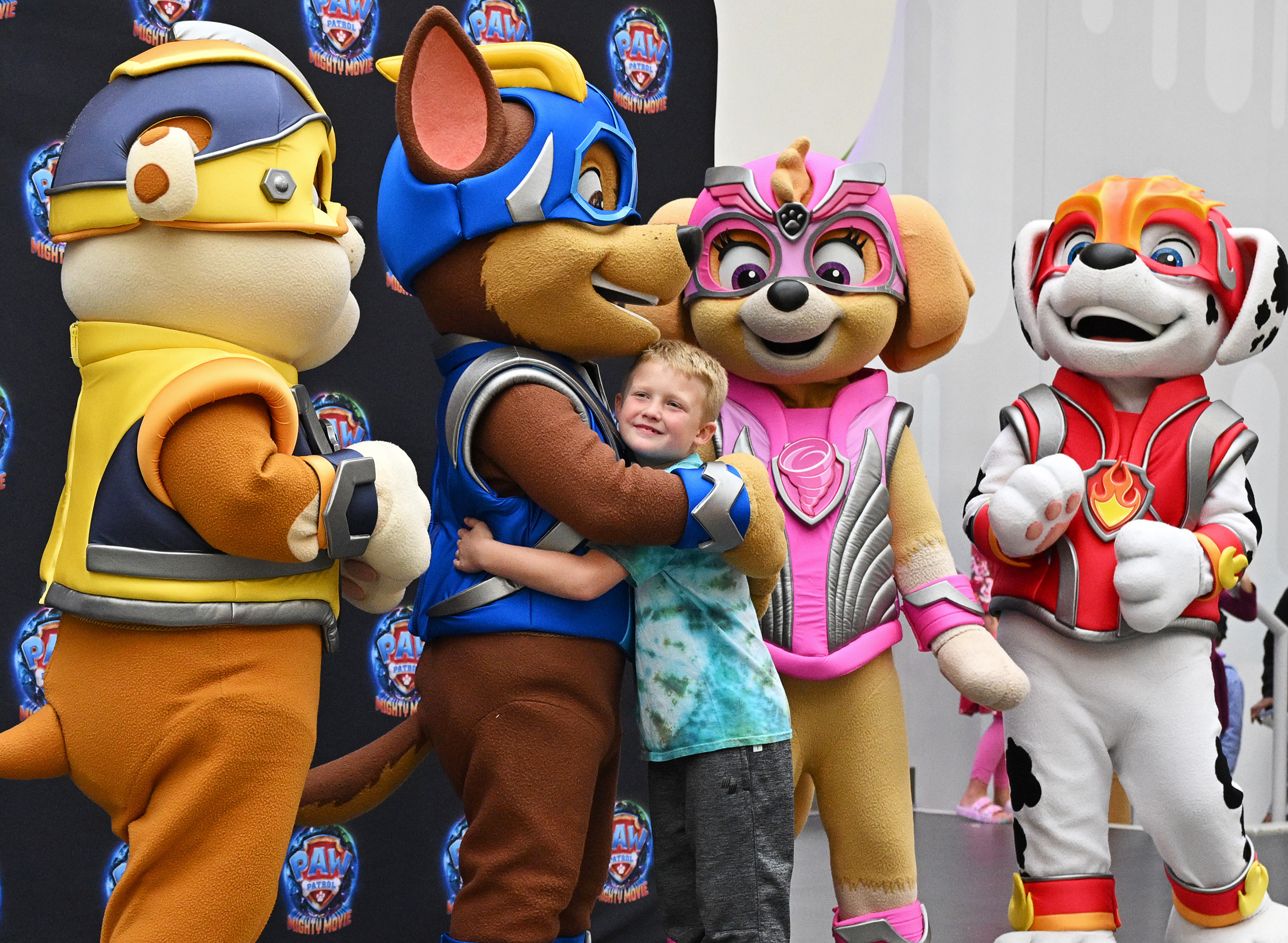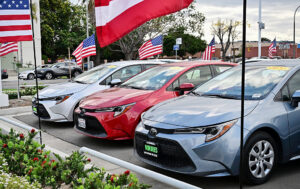Long before he started watching TV, people started giving my son stuff decorated with cute cartoon puppies dressed in distinctive outfits. There was a Dalmatian dressed as a fireman. A bulldog construction worker. A German shepherd police officer. I could not figure out why these brightly colored dogs seemed to be on roughly half the gear in our house, from shirts and hats to umbrellas and fire trucks.
What I learned was that the puppies were characters in a TV show called Paw Patrol, which is about the adventures of a 10-year-old boy named Ryder and a crew of puppies who help people. The show is a children’s-entertainment juggernaut. Paw Patrol, which airs on Nickelodeon and is available to stream on YouTube, Paramount+, and other platforms, has been the third most in-demand children’s TV series worldwide since at least 2020, beating out shows like Cocomelon, Bluey, and Peppa Pig, according to Parrot Analytics. (In the U.S., only SpongeBob SquarePants and Sesame Street ranked higher.) In 2021, Paramount premiered a Paw Patrol movie–one of the first films targeted at the preschool set–and it grossed $144 million worldwide. A sequel in 2023 raked in even more money, and a third is in the works.
But where Paw Patrol is really without peer is in the realm of children’s merchandising. Go into a Walmart or a Target and you’ll find Paw Patrol everywhere–on the diapers, the toothpaste, the Band-Aids, the cereal, and, of course, in the toy aisle. Paramount estimates that there are around 100,000 different Paw Patrol products. It was the top preschool toy property in each of the past two years in the U.S., the U.K., Spain, the Netherlands, Italy, France, Canada, Belgium, and Australia, according to the market-research company Circana. To date, Paw Patrol toys and other consumer products have racked up more than $15 billion in retail sales worldwide, according to Paramount, which owns Nickelodeon.
Paw Patrol was created in 2010 by Spin Master, a Canadian toy company. At the time, Spin Master was known for selling gadgets like juggling sticks and radio-controlled airplanes; it had almost no track record in television. And while it’s not unprecedented for TV shows to be based on toys–in the 1980s, both G.I. Joe and My Little Pony followed this path–Spin Master’s innovation was to create a TV show and a toy brand in tandem from the start, with both the toymaking and entertainment sides influencing one another. “Typically, entertainment leads the way,” says Amanda Cioletti, vice president of content and strategy at License Global, a trade publication. “But they came together from the very beginning and created a television series that was simultaneously rooted in product.”
It is now conventional for film studios to launch movies alongside merchandise–just look at all the Wicked goods that have gone on sale since the movie’s November 2024 opening. But when Paw Patrol premiered, it was unusual for TV shows to even have much advance merchandise, let alone for writers to consider it as they created the show. Now, because of the show’s success, more consumer-product executives want a seat at the entertainment table, Cioletti says. “They’ve created this successful way to build a franchise,” says Cioletti, “and now it’s become a reputable model for other entertainment and toy companies.”
Spin Master is broadening this strategy. The company is growing its Hollywood presence so that it can greenlight more movies and franchises outside of Paw Patrol, and the toys that go with them. “We love the art of storytelling and character creation,” says Ronnen Harary, co-founder of Spin Master, “so we’re going to expand our storytelling scope.”
Whether this is a good thing for children is a different matter. Paw Patrol is not particularly educational; it doesn’t, for example, teach children specific letters or numbers, like Sesame Street, or lessons about how to navigate difficult childhood situations, like Daniel Tiger. Critics have questioned the show’s negative portrayal of government–the two mayors in the show are incompetent–and dubbed it “Copaganda” for the way it glamorizes law enforcement. Then there’s the question of whether parents want merchandising opportunities to shape the programming their kids watch. If it feels normal for writers to create a show that the marketing division then commercializes, a threshold has been passed when toymakers create a show for kids with one eye turned toward getting their parents to buy products.

On a recent Wednesday, a 10-year-old boy named Jesse Gervasi stands in a recording booth in Toronto, a baseball cap pulled over his eyes and his hands tucked into the pocket of his hoodie. Gervasi, who voices Marshall, the Dalmatian fire pup, is reading lines for an upcoming Paw Patrol episode that involves farming. The character is goofy and a little bit clumsy; in this episode, like many others, Marshall trips before giggling out a pun. “Whew, didn’t see-d that coming,” Gervasi says. Editors in the booth tell him to emphasize the d to highlight the farming joke. Eventually, Gervasi gets it right, and he moves on to the next line: “Ryder needs us!” It’s a phrase repeated in every episode, a cue for the pups to rush to the Paw Patrol Lookout to find out their mission.
This is a typical plot for a show about the hijinks of puppies who occupy a world of inept adults, and whose salvation is a precocious 10-year-old boy with a lot of dogs. Each episode follows a similar format. A human or fellow animal gets in trouble. Ryder calls the pups together. He selects which ones will best be able to help him on their mission, and they get into their vehicles and set out to rescue someone.
Paw Patrol began with a marketer’s insight about what draws children in, and a recognition of Spin Master’s limitations. Toymakers like Spin Master don’t typically invent toys themselves. Instead, they scout ideas from inventors. Founded in 1994 by two recent college graduates, Spin Master had done well commercializing concepts like Earth Buddy, a potato-like head that grows grass for hair, and Air Hogs, which are remote-controlled airplanes. But 15 years ago, it was struggling to get into the lucrative business of making toys based on popular characters like Mickey Mouse. “We eventually figured, if we can’t get a character license, let’s create one of our own,” says Harary.
The company’s first attempt, in 2008, was Bakugan, a ball that transforms into different action figures. The toy spawned a TV show and became a billion-dollar business. But after about four years, sales slumped and Spin Master laid off more than 300 employees.
What kids liked most about Bakugan was that it transformed from one thing into another. So Spin Master decided to put out a call for ideas about toys that involved transformation, hoping to find one it could simultaneously develop into a TV show. “The idea really was about controlling our own destiny to be able to develop, create, and produce series, since we didn’t have a drawer full of brands like other companies,” says Jennifer Dodge, who joined Spin Master in 2009 to launch its entertainment studio.
A pitch from a toy creator named Keith Chapman fit the bill. Chapman’s concept was about a boy named Robbie, who worked with a team of rescue pups to help people. (Robbie was later changed to Ryder.) The company got to work developing the story behind the pups, drawing on its own expertise with “play patterns”–essentially how kids entertain themselves, Harary says. Executives brought in both animators and toy designers who worked together to create characters and storylines. “It really became an iterative process between toy designers and animation designers working together,” Dodge says.
At the time, Spin Master had about 900 employees, but its entertainment division consisted of only four people. Still, with Spin Master’s input, the show evolved from a concept about rescue pups to one about pups whose backpacks transform into tools, a key facet of the toys it would sell. The toy designers helped determine what the pups and their vehicles and houses would look like, and assisted in picking the different dog breeds and giving them personalities.
Paw Patrol was a hit from the moment it aired in 2013, quickly becoming Nickelodeon’s highest-rated preschool show. Spin Master was ready with toys that rolled out to market within a few months: the Lookout, the dogs, their doghouses, the many bigger vehicles, like cargo ships and airplanes, that carry the pups to different locations. As the show grew in popularity, the company added “an extensive products and experiences program,” as Paramount puts it, that includes clothes, video games, live stage tours, theme-park attractions, and toys.
More than a decade since its debut, the show continues to be shaped by merchandising opportunities. Spin Master changes the theme of the episodes every few seasons. The pups become Aqua Pups who wear scuba gear, or medieval knights who wear armor, or super pups with superpowers–all changes that create new toys for parents to buy their eager children. “It’s like, how do you make a fire truck look different each time?” Dodge says. “How can it have features or do something innovative that we’ve never done before?”
All this merchandising can make the Paw Patrol universe feel inescapable to parents. “We live and breathe Paw Patrol,” says Andrea Jordan, a nurse from Richmond, Va., whose 3 ½-year-old daughter is obsessed with the show. Jordan has spotted Paw Patrol logos adorning nap mats, bath toys, even once on a hospital cap. Though its ubiquity can be unnerving, Jordan says that she is glad the show at least teaches children about the importance of kindness.
Parents of young children may have been young kids themselves when this became possible. Until 1984, the Federal Communications Commission imposed time limits on how much advertising could air during children’s programming. But that year, the FCC removed those limits at the urging of Ronald Reagan, who argued that such regulation limited free speech. This deregulation prompted toy manufacturers to become heavily involved in children’s programming, sometimes offering broadcasters a cut of toy sales if they aired certain shows. In 1991, the FCC restored some time limits on advertising during children’s programming, but toy companies and their products had become so intertwined with shows by then that the new regulations didn’t make much of a difference.
Today, most children’s TV shows are built around licensed characters who are also slapped on food products and clothes and made into toys. The problem with this is that children play less creatively with toys linked to media properties, says Susan Linn, a psychologist and the author of Who’s Raising the Kids? When they play, for instance, with wooden blocks or anonymous dolls, Linn notes, children may make up their own worlds and use their imaginations. When they play with Paw Patrol–branded gear or SpongeBob Square Pants toys, they’ll likely just be re-creating the storylines they saw on TV. “Creative play is the foundation of learning,” Linn says. “Stifling that creativity deprives them of what has forever been a part of healthy play.”
Still, it’s hard to blame studios for using licensing to turn their creative properties into revenue streams. As more families eschew traditional networks and embrace content on platforms like YouTube, it can be harder for studios to come up with the cash needed to fund children’s programming, says Nancy Jennings, a professor at the University of Cincinnati who studies media’s impact on children. As a result, creators are trying to seek out other avenues, like licensing and merchandising, to make money.
Paw Patrol succeeds at this in part because of its global appeal. The pups don’t belong to any particular country or racial group, which makes it easy for any kid to identify with them. (The cartoon has been translated into 32 languages; it’s the No. 1 “linear” program on Nick Jr. in 10 countries.) All the characters are kind to one another. And the pups’ jobs are familiar to children the world over whose “first hero” is a police officer or firefighter who they see doing work in their community, says Dodge, the Spin Master executive.
Being inescapable and globally appealing is, of course, part of the company’s strategy. Almost all kids like puppies, and thanks to Paw Patrol, they can wear them on their clothes and snack on their likenesses–even if they don’t watch TV.
















